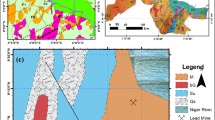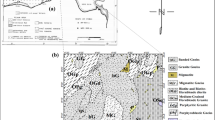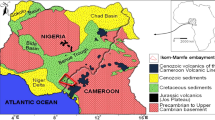Abstract
This paper describes an application of diverse geophysical methods to detect the geological contacts in the Tomelilla area, Sweden. Airborne magnetic data and the tipper and peaker maps derived from tensor very-low-frequency electromagnetic (TVLF-EM) data are interpreted in order to indicate most geological boundaries. The inverted airborne TVLF data along adjacent profiles over each contact show the resistivity variations at depth and laterally localize the geological contacts while delineating resistive bedrocks in all cases. To control the resistivity images across these profiles, the ground-based measurements of the radio magnetotelluric data combined with controlled-source magnetotelluric data (RMT/CSMT) have been performed to plot resistivity variations with higher resolution. The obtained resistivity images are in good agreement with the ones acquired from airborne TVLF data. A relatively conductive layer with an average thickness of 20 to 30 m of the Quaternary deposits, increasing in thickness from east to the west, and a resistive basement with much higher resistivity on the granites than the shales are resolved from the geoelectric sections. This paper confirms that the combined geophysical surveys (i.e., airborne magnetometry/TVLF along with ground-based RMT/CSMT) reduce the uncertainty arising from geological mapping. It is shown that the airborne TVLF data have high capability for image resistivity variation along geological contacts in the study area while its resolution has been confirmed by the ground-based RMT/CSMT survey.










Similar content being viewed by others
References
Abedi M, Gholami A, Norouzi GH (2014) 3D inversion of magnetic data seeking sharp boundaries: a case study for a porphyry copper deposit from Now Chun in central Iran. Near Surf Geophys. doi:10.3997/1873-0604.2014022
Barfield RH (1934) Some measurements of the electric constants of the ground at short wavelengths by the wave tilt method. Proc IEEE 75:214–220
Bastani M, Malehmir A, Ismail N, Pedersen LB, Hedjazi F (2009) Delineating hydrothermal stockwork copper deposits using controlled-source and radio-magnetotelluric methods: a case study from northeast Iran. Geophysics 74:B167–B181
Beamish D (1994) Two-dimensional, regularized inversion of VLF data. J Appl Geophysics 32:357–374
Beamish D (2000) Quantitative 2D VLF data interpretation. J Appl Geophysics 45:33–47
Chouteau M, Zhang P, Chapellier D (1996) Computation of apparent resistivity profiles from VLF-EM data using linear filtering. Geophys Prospect 44:215–232
Daniel S (1999) Beskrivning till jordartskartan 2D Tomelilla NV. SGU serie Ae 123: Skala 1:50000
DeGroot-Hedlin C, Constable S (1990) Occam’s inversion to generate smooth, two-dimensional models from magnetotelluric data. Geophysics 55:1613–1624
Erlström M, Guy-Ohlson D (1999) An Upper Triassic, Norian-Rhaetian, outlier in Skåne, southern Sweden. Bull Geol Soc Den 45:89–97
Feldman CB (1933) The optical behaviour of the ground short radio waves. Proc IEEE 75:214–220
Gharibi M, Pedersen LB (1999) Transformation of VLF data into apparent resistivities and phases. Geophysics 64:1393–1402
Gholami A, Siahkoohi HR (2010) Regularization of linear and nonlinear geophysical ill-posed problems with joint sparsity constraints. Geophys J Int 180:871–882
Khalil MA, Monteiro Santos F (2011) Comparative study between filtering and inversion of VLF-EM profile data. Arab J Geosci 4:309–317
Khalil MA, Monteiro Santos F (2013) On the depth to anomaly estimation using Karous and Hjelt filter in VLF-EM data. Arab J Geosci. doi:10.1007/s12517-013-1110-3
Lindström S, Erlström M (2011) The Jurassic-Cretaceous transition of the Fararp-1 core, southern Sweden: sedimentological and phytological indications of climate change. Palaeogeogr, Palaeoclimatol, Palaeoecol 308:445
McNeill JD, Labson VF (1989) Geological mapping using VLF radio fields. In: Electromagnetic methods in applied geophysics, 2, part B (ed. M.M. Nabighian), Ch. 7, SEG, Tulsa
Monteiro Santos FA, Mateus A, Figueiras J, Gonçalves MA (2006) Mapping groundwater contamination around a landfill facility using the VLF-EM method—a case study. J Appleophysics 60:115–125
Newman GA, Recher S, Tezkan B, Neubauer FM (2003) 3D inversion of a scalar radio magnetotelluric field data set. Geophysics 68:791–802
Oskooi B (2004) A broad view on the interpretation of electromagnetic data (VLF, RMT, MT, CSTMT). PhD Thesis, Uppsala University, 67pp
Oskooi B, Pedersen LB (2001) Processing and interpretation of tensor VLF data. Report: SGU reference number 03-1016/97 September
Oskooi B, Pedersen LB (2005) Comparison between VLF and RMT methods, a combined tool for mapping conductivity changes in the sedimentary cover. J Appl Geophys 57:227–241
Oskooi B, Pedersen LB (2006) Resolution of airborne VLF data. J Appl Geophys 58:158–175
Paal G (1965) Ore prospecting based on VLF-radio signals. Geoexploration 3:139–147
Paal G (1968) Very low frequency measurements in northern Sweden. Geoexploration 6:141–149
Pedersen LB (2004) Determination of the regularization level of truncated singular-value decomposition inversion: the case of 1D inversion of MT data. Geophys Prospect 52:261–270
Pedersen LB, Engels M (2005) Routine 2D inversion of magnetotelluric data using the determinant of the impedance tensor. Geophys 70:33–41
Pedersen LB, Oskooi B (2004) Airborne VLF measurements and variations of ground conductivity: a tutorial. Surv Geophys 25:151–181
Pedersen LB, Qian W, Dynesius L, Zhang P (1994) An airborne tensor VLF system. From concept to realization. Geophys Prospect 42:863–883
Pedersen LB, Bastani M, Dynesius L (2005) Groundwater exploration using combined controlled-source and radiomagnetotelluric techniques. Geophysics 70:G8–G15
Persson L, Lundin IA, Pedersen LB, Claeson D (2011) Combined magnetic, electromagnetic and resistivity study over a highly conductive formation in Orrivaara, Northern Sweden. Geophysl Prospect 59:1155–1163
Sinha AK, Hayles JC (1988) Experiences with a local loop VLF transmitter for geological studies in the Canadian nuclear fuel waste management program. Geoexploration 25:37–60
Siripunvaraporn W, Egbert G (2000) An efficient data-subspace inversion method for 2-D magnetotelluric data. Geophysics 65:791–803
Slattery SR, Andriashek LD (2012) Overview of airborne electromagnetic and magnetic geophysical data collection using the TEMPEST survey near Edmonton, Alberta. ERCB/AGS Open File Report 2012-11
Smith-Rose RL (1933) The electrical properties of soil for alternating currents at radio frequencies. Proc R Soc London 140:359–377
Sundararajan N, Babu RV, Chaturvedi AK (2011) Detection of basement fractures favourable to uranium mineralization from VLF-EM signals. J Geophys Eng 8:330–340
Tikhonov AN, Arsenin VY (1977) Solutions of ill-posed problems. Winston, Washington, D.C
Acknowledgments
The authors thank the Geological Survey of Sweden for providing airborne magnetic and TVLF-EM data. We also thank the Department of Earth Sciences of Uppsala University for the RMT data which were collected under the supervision of Professor Pedersen while the first author was studying there in 2001. We would like to appreciate Professors Siripunvaraporn and Egbert for providing their code to model the data. The Institute of Geophysics of the University of Tehran is acknowledged for providing facilities for reprocessing all old data.
Author information
Authors and Affiliations
Corresponding author
Rights and permissions
About this article
Cite this article
Oskooi, B., Abedi, M. Magnetic and electromagnetic data interpretation for delineating geological contacts in the Tomelilla area, Sweden. Arab J Geosci 8, 3971–3984 (2015). https://doi.org/10.1007/s12517-014-1501-0
Received:
Accepted:
Published:
Issue Date:
DOI: https://doi.org/10.1007/s12517-014-1501-0




